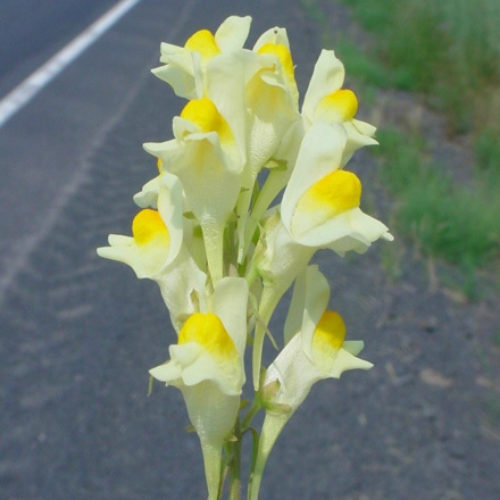Yellow Toadflax
Linaria vulgaris

Family: Plantaginaceae
Other Common Names: butter and eggs, common toadflax, wild snapdragon
Weed class: C
Year Listed: 1988
Native to: Europe and Asia
Is this Weed Toxic?:
not known to be
Why Is It a Noxious Weed?
Yellow toadflax can invade rangeland and cultivated fields and compete with desirable plants and reduce their yield. It is seldom eaten by livestock.
How would I identify it?
General Description
Perennial that grows 8 to 31 inches tall from creeping roots, often forming colonies. Plants are light green and have yellow flowers with orange throats and bloom during the summer (June to September). It has a bad smell.
Flower Description
Flowers are crowded onto the top 2 to 9 inches of the plant stem. They are yellow with hairy, orange throats. They resemble snapdragons, each having a spur-like appendage at the base.
Leaf description
Leaves are alternately arranged and numerous along the stem. Each leaf is very narrow (linear) and up to 3.9 inches (10 cm) long. They are hairless and have pointed tips.
Stem description
Stems are generally unbranched.
Fruit Seed Description
Flowers form a cylindrical capsule that is about .4 inches long. Seeds are dark in color, brown to black, and are flattened, having a papery wing.
May Be Confused With
Dalmatian toadflax, Linaria dalmatica ssp. dalmatica, is similar in appearance. If you need help with plant identification, please contact your county noxious weed coordinator.
Where does it grow?
Yellow toadflax is found in a variety of habitats including roadsides, edges of fields, rangelands, meadows, cultivated fields and wastelands. Please click here to see a county level distribution map of yellow toadflax in Washington.
How Does it Reproduce?
Yellow toadflax can reproduce by seeds and by its horizontal rootstalks which send up new shoots.
How Do I Control It?
Mechanical Control
Cultivation of infested fields should begin in early summer and be repeated every 21 days. One year of thorough cultivation (8 or more times over) will eliminate a high percentage.
Cultural Control
.
Biological Control
The toadflax flower-feeding beetle, Brachypterolus pulcarius, larvae feed on the reproductive structures within the flowers, including the seeds, and adults feed on young plant stems. The toadflax seed capsule weevil, Rhinusa antirrhini (formerly Gymnetron), larvae feed on immature seeds and adults feed on flowers and young shoots. For more information about biological control of yellow toadflax, please visit WSU Extension Integrated Weed Control Project.
Herbicide Control
Please refer to the PNW Weed Management Handbook, or contact your county noxious weed coordinator.
For More Information
See our Written Findings for more information about yellow toadflax (Linaria vulgaris).
Report on yellow toadflax from the book "Weed Control in Natural Areas in the Western United States"
Lincoln County NWCB Brochure on yellow toadflax












